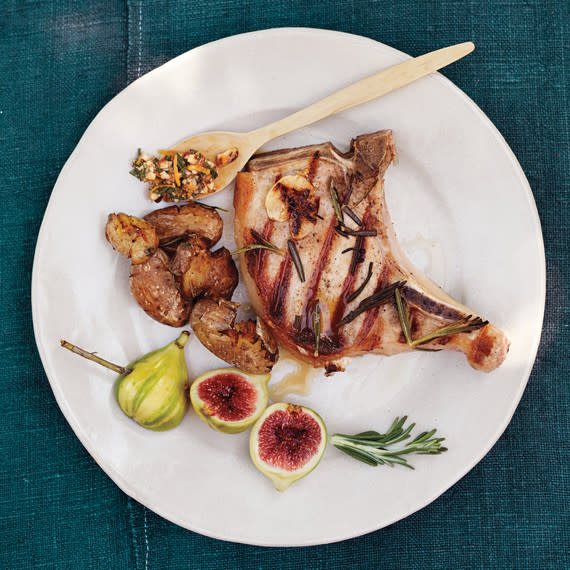What You Need to Know to Successfully Grill Pork Chops

Grilling pork chops might seem just as straightforward as grilling a T-Bone or rib-eye steak, but naturally lean meat has a tendency to dry out. That means pork chops can become chewy and rubbery when exposed to high heat for too long. It is possible to get a char on a pork chop without drying it out if you start with the right cut: "Using a bone-in pork chop will help keep the meat nice and moist in such an intense heat," says associate food editor Riley Wofford. While boneless pork chops might seem easier to cook, on the grill they are easier to burn—a bone can help evenly diffuse the heat of open flames. Look for pork chops that shows signs of marbling and range in color from pink to pale red; avoid any chops that show signs of graying. And always bring pork chops to room temperature before grilling. Wofford says if you try to grill frozen or barely defrosted meat, the outside of the pork chop will scorch while the center remains cold.
Below Wofford shares more expert advice for grilling pork chops successfully.
RELATED: Our Guide to the Best Budget Steak Cuts
How to Prep Pork Chops for the Grill
The beauty of grilled meat is the flavorful, smoky char. It intensifies the natural sweetness of the pork, so beyond a light salt and pepper seasoning, Wofford says nothing else is truly necessary. That doesn't mean that pork shouldn't be marinated or brined: "Marinating will only do good things—it will add flavor and tenderize the meat a bit," she says. Her favorite marinade has an olive-oil-base with dried oregano, fennel seeds, and lemon zest plus salt and pepper. She'll use it to marinate the chops for a few hours before grilling. Spice pastes and rubs are a quick way to add different flavors to chops and there's the added benefit of a crust that forms when the chop is grilled.
Why Size Matters
The thicker the chop, the longer it will take to dry out. "A thin cut will just need a quick turn over direct heat, whereas a thicker chop may need to start on direct heat to get good grill marks—and then be moved over to indirect heat to finish cooking through," Wofford says. A general rule of thumb is that it takes about ten minutes to cook an inch-thick cut of most proteins, and that's also true for pork that's an inch thick. Thinly sliced pork chops cook in five to six minutes, especially if they're less than half-an-inch thick.
Resting Time
Wooford says this step is essential: "Letting meat rest helps seal in the juices." The downtime will allow moisture to re-enter the meat. "That way, when you cut into the meat, the juices stay inside your beef or pork rather than spilling out onto your cutting board, and your meal stays juicy. Try placing aluminum foil over the chops while they rest; it'll help keep the meat hot.
